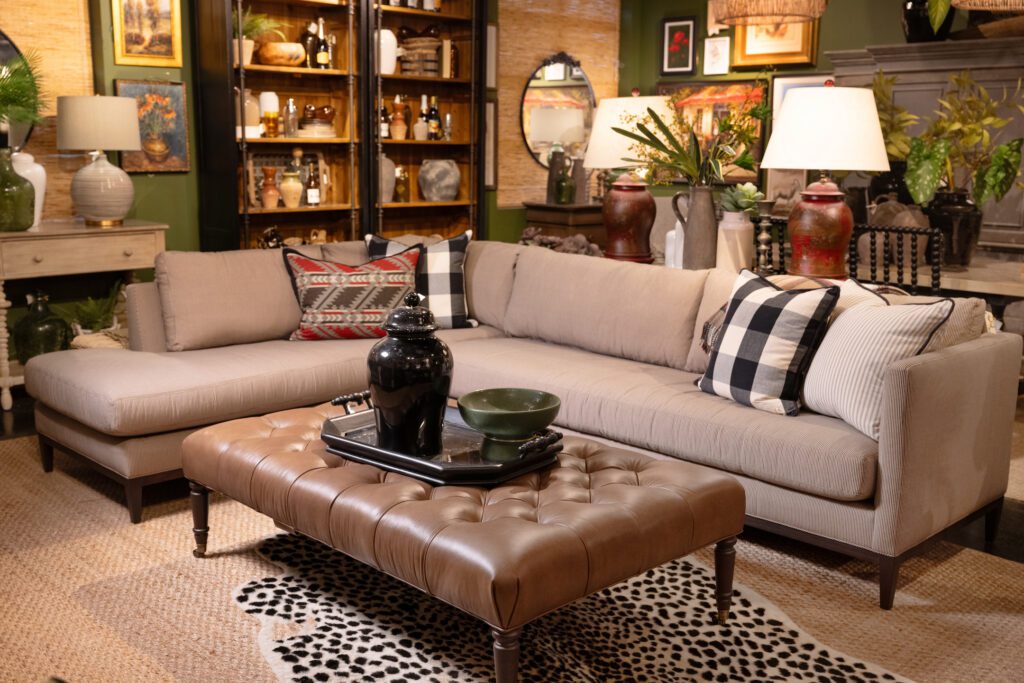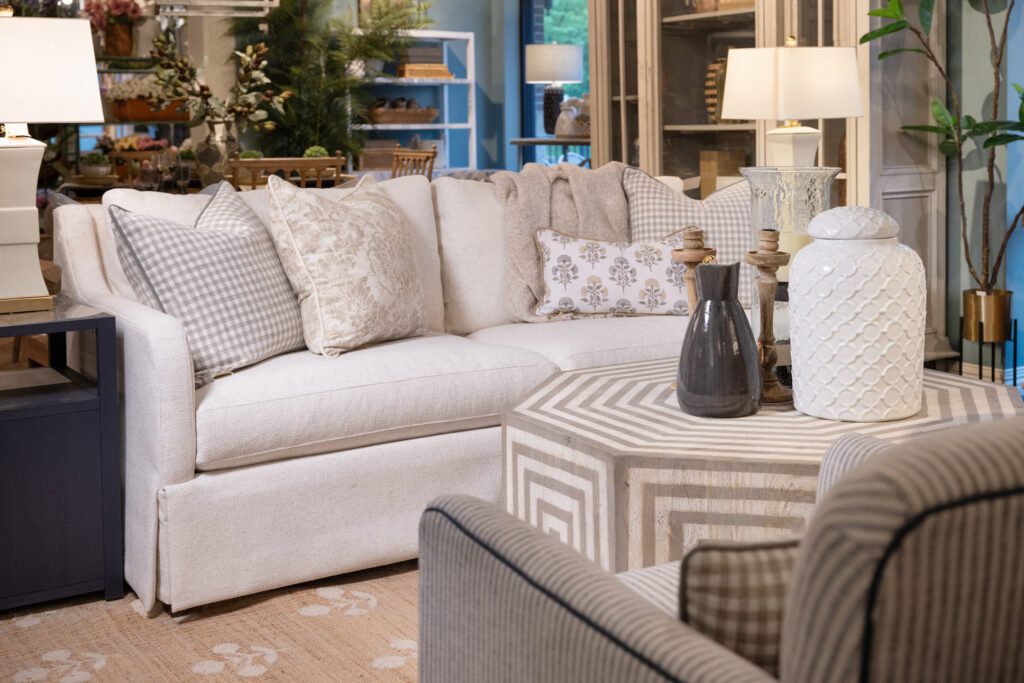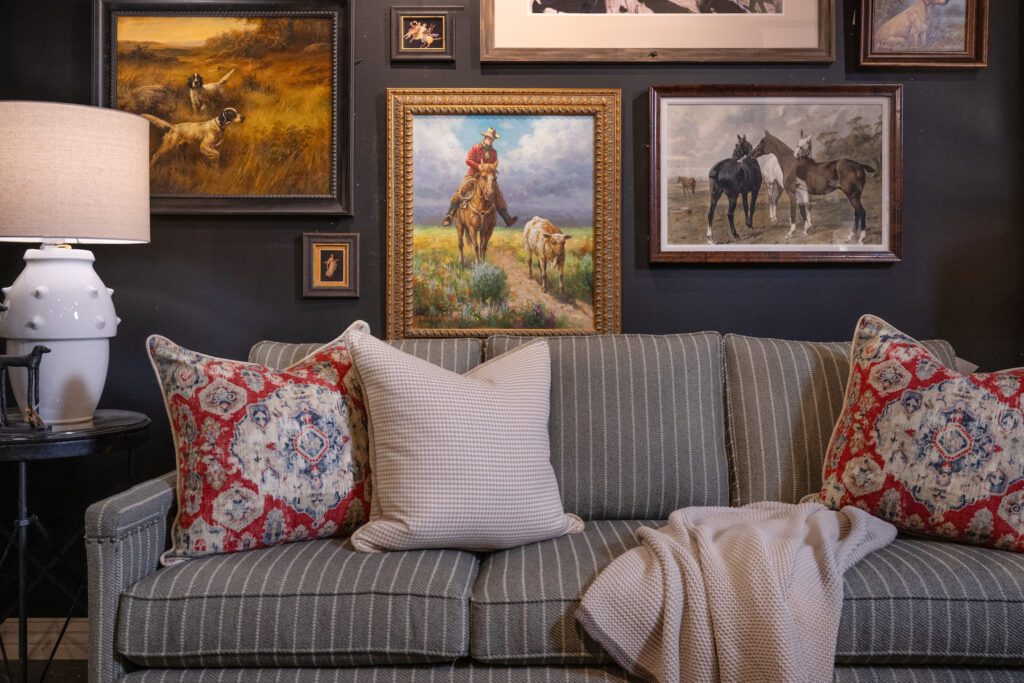When it comes to customizing furniture or working with a designer, having a good grasp of the terminology can make all the difference in bringing your vision to life. At Nell Hill’s, we believe that knowledge is power, and understanding the specific language of furniture design and construction helps ensure you get exactly what you want. From the intricacies of different arm styles to the subtle differences in tufting techniques, each term adds a layer of clarity to the creative process. Whether you’re customizing a sofa, selecting the perfect pillows, or simply refining your decor, these definitions will empower you to make informed, confident decisions in your design journey.

Styles
In the world of custom upholstery, the sky is the limit when it comes to making a piece your own. That said, there are several classic styles that we often use as a starting point; whose shapes have stood the test of time and look fantastic in the fabrics, leathers and finishes we use today.
Chesterfield
A Chesterfield is a classic style of sofa known for its deep button-tufting, high rolled arms, and low back, which are typically the same height. Often upholstered in leather, it exudes a sophisticated and timeless elegance, making it a staple in traditional and contemporary interiors alike.

Tuxedo
A Tuxedo sofa is characterized by its straight lines and sleek, boxy silhouette. The arms and back are the same height, creating a uniform, tailored look. This style is often seen in modern and Art Deco designs, offering a chic and sophisticated touch to any room.
English
The English or English rolled arm sofa is distinguished by its low, tight back, soft, cushioned seat, and arms that are slightly rolled. This style combines comfort with a casual elegance, making it a popular choice for cozy and inviting living spaces.

Camel Back
The Camel Back sofa features a distinctive hump-shaped backrest that rises in the center and slopes down towards the arms. This elegant design, often associated with 18th-century furniture, adds a touch of sophistication and a graceful silhouette to traditional interiors.
Loveseat
A Loveseat is a small sofa designed to seat two people. It is perfect for cozy seating arrangements in smaller spaces or as a complement to a larger sofa. Loveseats come in various styles, from classic to contemporary, making them versatile and functional pieces.
Settee
A Settee is a small, upholstered seat with a back and arms, designed to accommodate two or more people. It is typically more formal and delicate than a loveseat, often used in entryways, bedrooms, or as an accent piece in living rooms.
Sectional
A Sectional sofa is a versatile seating solution composed of multiple sections that can be arranged in various configurations to fit different spaces. This style often includes a combination of a sofa, chaise, and sometimes even recliners, providing ample seating and flexibility for larger rooms.

Cabriole Leg
The Cabriole leg is a furniture leg style characterized by its elegant, curved shape. The upper part of the leg curves outward, while the lower part curves inward, often ending in a decorative foot. This classic design is commonly seen in antique and traditional furniture, adding a touch of grace and sophistication.

Chaise
A Chaise, short for chaise lounge, is an elongated chair designed for reclining. It typically has a long seat with a backrest at one end, allowing you to stretch out comfortably. Chaises are perfect for adding a luxurious and relaxing element to living rooms, bedrooms, or reading nooks.
Daybed
A Daybed is a versatile piece of furniture that serves as both a sofa and a bed. It often features a bench cushion roughly the side of a twin mattress, making it perfect for lounging during the day and accommodating guests at night. Daybeds are ideal for small spaces, offering functionality without sacrificing style.
Arm Styles
Arms can drive the aesthetic of a chair or sofa and there are quite a few options from which to choose. From the tall, structured arm of a Chesterfield that extends from the back of the sofa at the same height to frames that are altogether armless, your arm selection can help you make just the right statement for your space. Let’s dig into some of our favorite options!
Rolled Arm
A rolled arm is a classic, traditional style of arm on furniture, characterized by its rounded, outward curve. This design is often found on sofas and chairs, adding a touch of both elegance and comfort. The rolled arm typically features ample padding, making it a cozy option for lounging.
Track or Square Arm
A track or square arm is a sleek arm style defined by its straight, clean lines and right angles. This type of arm is often associated with contemporary and minimalist furniture designs, offering a sharp, structured look that complements modern interiors, or adds a touch of modernity to an otherwise traditional space.
Tuxedo Arm
The tuxedo arm is a style that is level with the back of the piece, creating a uniform height around the perimeter of the furniture. This style often features clean, straight lines and is named for its sophisticated, tailored appearance, much like a tuxedo suit. It is commonly found on sofas and chairs with a more formal and elegant aesthetic.
English Arm or English Rolled Arm/Saddle
The English arm, also known as the English rolled arm, is a refined and understated arm style. It features a low, gently rolled curve and is often paired with a tight, fitted upholstery. The arm fabric is typically pleated around the slope over the arm, creating an elegant detail while ensuring the textile flows over the frame with a snug fit. This style is a hallmark of traditional English furniture design.
Key Arm
The Key arm, also known as a keyhole arm, is characterized by its unique, angular design that resembles the shape of a keyhole. This arm style typically features a squared-off look with a distinctive cutout or notch near the top. The clean, geometric lines make the key arm a popular choice for contemporary and transitional furniture, adding a touch of modern sophistication to any piece.
Pleated Arm
The Pleated arm is distinguished by its elegantly gathered or folded fabric, which creates a series of vertical pleats along the arm’s surface. This design adds texture and a touch of classic charm to a sofa or chair. Pleated arms are often found in traditional or formal settings, providing a refined and sophisticated look.
Shelter Arm
The Shelter arm is characterized by its high, slightly curved design that extends around the back of the sofa or chair, creating a cozy, enveloping effect. This style provides both visual interest and added comfort, as the arms form a protective, cocoon-like structure. Shelter arms are commonly seen in both modern and transitional furniture, offering a blend of contemporary style and inviting comfort.

Modern Scroll Arm
The Modern Scroll arm combines the classic elegance of a traditional scroll arm with a contemporary twist. This style features a gentle, outward curving design that resembles a rolled scroll but with cleaner lines and a more streamlined appearance. The modern scroll arm adds a touch of timeless grace to sofas and chairs, making it a versatile choice that works well in both traditional and modern interiors.
Back Styles
Tight Back
A tight back refers to a style of furniture where the back cushion is attached directly to the frame, providing a firm and supportive seating experience. Unlike loose or cushioned backs, tight backs do not have removable cushions, giving the furniture a clean and tailored appearance.

Tufted Back
A tufted back is a decorative upholstery technique where the fabric is pulled and sewn into evenly spaced buttons, creating a series of depressions or “tufts” across the back of the furniture. This style adds a touch of luxury and texture, often found in traditional and vintage-inspired pieces. Tufting looks great in everything from linen to leather, and in a variety of patterns, though solids and small scale prints work particularly well. Tufting significantly alters the appearance of a pattern, so be aware when applying linear and large-scale patterns to a frame with tufting.
Cushioned Back
A cushioned back features loose, removable cushions that provide a plush and comfortable seating experience. This style allows for easy cleaning and fluffing of the cushions, and offers a more relaxed and inviting look compared to a tight back. Cushioned backs are versatile and can be found in a variety of furniture styles, from casual to formal.

Cushions and Cushion Configurations
Choosing the right cushion configuration is a crucial step in customizing your furniture, as it significantly impacts both the comfort and aesthetic of your piece. At Nell Hill’s, we want to ensure you have all the knowledge you need to make informed decisions. Whether you’re seeking a sleek, modern look with a bench seat or the tailored elegance of T-cushions, our knowledgeable team is here to guide you every step of the way.
Cushion Configurations
2 Over 2
This cushion configuration features two seat cushions paired with two back cushions. It’s a balanced and symmetrical design that offers a clean, contemporary look. The 2 over 2 setup is ideal for medium to large sofas, providing ample seating space while maintaining a streamlined appearance.

3 Over 3
This configuration includes three seat cushions paired with three back cushions. It’s a popular choice for larger sofas, offering maximum seating capacity and a comfortable, even distribution of support. The 3 over 3 design is perfect for families or those who frequently entertain, as it provides plenty of individual seating spots.

2 or 3 Over 1
In this configuration, two or three back cushions are combined with a single, long seat cushion, also known as a bench seat. This design creates a seamless, uninterrupted seating surface, which is great for lounging and accommodating multiple people comfortably. The bench seat gives a sleek, modern look and is often found in contemporary and transitional styles.
T-Cushions
T-cushions are designed to wrap around the arms of a sofa or chair, creating a distinctive “T” shape. This configuration allows for a snug fit against the armrests, providing extra comfort and a tailored appearance. T-cushions are often used in traditional and classic furniture designs.

Attached and Semi-Attached Cushions
Attached Cushions
In this style, the cushions are sewn or otherwise permanently fixed to the frame of the furniture. This design ensures that the cushions stay in place and maintain a neat, tidy appearance. While you can’t flip or rotate an attached cushion, you should fluff as able to prevent creases and wrinkles and prolong the integrity of the cushion’s shape.
Semi-Attached Cushions
Semi-attached cushions are partially secured to the frame, typically at the top or back, while the bottom remains loose. This configuration offers a balance between the fixed position of attached cushions and some of the flexibility of loose cushions. Semi-attached cushions provide a polished look with added comfort and easy maintenance, as they can be adjusted slightly without shifting out of place.
Legs
From frames that feature exposed wood (or metal) legs to legs that are fully upholstered, legs are yet another element that add to the overall aesthetic of a piece of upholstered furniture. Many exposed wood leg finishes can be customized from a palette of stains and paints, while others can have any color applied for the perfect color match.
Turned Leg
A turned leg is shaped using a lathe, which spins the wood while it is carved to create symmetrical, rounded designs. These legs often feature intricate details such as spirals, flutes, and bulbous shapes. Turned legs are commonly found on classic and traditional furniture pieces, like dining tables, chairs, and bed frames, adding a sense of craftsmanship and decorative appeal.

Block Leg
Block legs are simple, sturdy legs with a square or rectangular shape. They offer a clean and robust look, providing solid support for the furniture. Block legs are often found on contemporary and modern furniture designs, where the emphasis is on minimalism and functionality. They are commonly used on sofas, beds, and tables for a straightforward and unembellished aesthetic.
Tapered Leg
Tapered legs gradually decrease in thickness from top to bottom, creating a sleek and elegant profile. This design can be either straight or slightly curved, providing a sense of lightness and refinement. Tapered legs are versatile and used in various furniture styles, from mid-century modern to contemporary pieces. They are commonly found on chairs, tables, and sofas, contributing to a streamlined and sophisticated look.

Casters
Casters are small, swiveling wheels attached to the legs or base of furniture pieces, allowing them to be easily moved from one place to another. Typically made of metal, plastic, or rubber, casters can be either visible or concealed depending on the furniture design. They are commonly found on chairs, ottomans, and some tables, adding both functionality and mobility to the furniture.
Brass Capping
Brass capping refers to the decorative brass coverings placed at the ends of furniture legs. These caps serve both a functional and aesthetic purpose: they protect the ends of the legs from damage and wear while adding a touch of elegance and sophistication to the piece. Brass capping is often seen on traditional and antique-style furniture, enhancing the overall look with a polished finish.
As we wrap up part one of this journey through the world of furniture terminology, I hope you feel more empowered and confident in your design endeavors. Understanding these key words not only enhances your ability to communicate with our designers but also allows you to articulate your vision more clearly. Whether you’re customizing a piece of furniture or collaborating with a designer to bring your dream space to life, the knowledge gained from this guide will serve as a valuable asset.
At Nell Hill’s, we’re passionate about helping our customers create spaces that reflect their unique style and personality. Armed with these definitions, you’re well-equipped to navigate the exciting world of furniture design and create spaces that inspire and delight for years to come. Join me next week for part two, where we’ll talk about types of tufting, designer details (like our collective favorite – the contrast welt), and pillows. Until next time – happy decorating!


